Dedication of |
 The Nippon Foundation in the late 1990s pledged to build 100 primary schools in Cambodia, and the one dedicated today fulfilled that pledge. The Foundation, in signing the agreement to build the schools, specified that they must all be in former Khmer Rouge controlled areas to give those people more of a sense of hope and more of a future. Here Prime Minister Hun Sen addresses the crowd. He is quite the popular orator and knows how to move a crowd. He spoke for about forty-five minutes.
The Nippon Foundation in the late 1990s pledged to build 100 primary schools in Cambodia, and the one dedicated today fulfilled that pledge. The Foundation, in signing the agreement to build the schools, specified that they must all be in former Khmer Rouge controlled areas to give those people more of a sense of hope and more of a future. Here Prime Minister Hun Sen addresses the crowd. He is quite the popular orator and knows how to move a crowd. He spoke for about forty-five minutes.
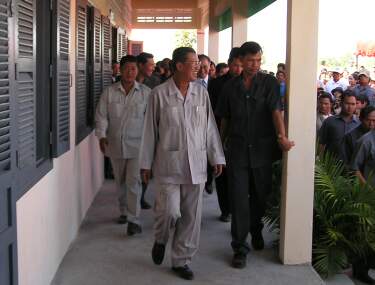
After the speeches and awarding medals to the officials from the Nippon Foundation, Hun Sen and his entourage toured the newly constructed school. It is a long, one-story building, six classrooms set side by side.
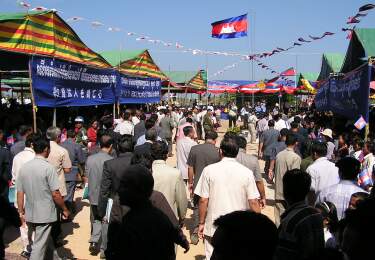
Occasions such as this school dedication are overtly political. The Prime Minister's speech is broadcast to the whole country, and pictures of the dedication were ready for the lunch-time news broadcasts. Those who invite the prime minister have to guarantee to assemble several thousand people and pay for the tents and chairs and any other accommodations.

The crowds were gathered from near and far for this dedication. Most are the poor farmers and villagers who live with a several mile radius of the school. Cambodian and Japanese flags were provided for them to wave. For most it is probably an exciting occasion to be able to see and be in the presence of their country's ruler.
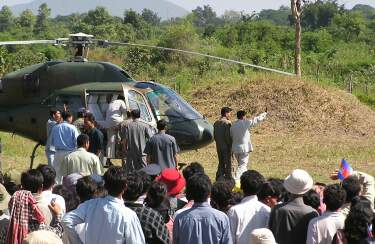
When traveling to ceremonies in the provinces, Hun Sen usually is ferried by a military helicopter. A second helicopter carries other officials and security people. Here he boards the chopper for the return trip after the dedication.
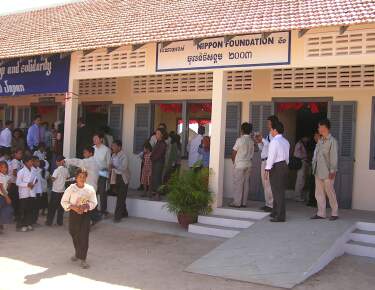
The new school is one long building with six classrooms side by side. In the speech of Mr. Yohei Sasakawa, the president of the Nippon Foundation, he made a point of noting the building had been made with toilets (many schools don't have them) and a ramp to make it wheelchair accessible.
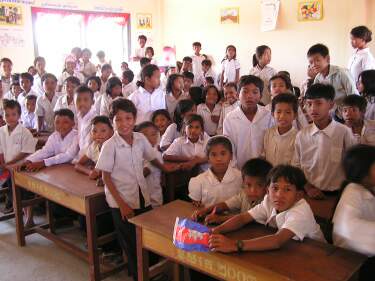
The building can be brand new and have a ramp but some of the major problems of Cambodian education still persist. These children now have a new school building but there will be more than fifty kids in this classroom! I saw one mother carry her son with a deformed leg into the classroom to make sure he wasn't excluded.
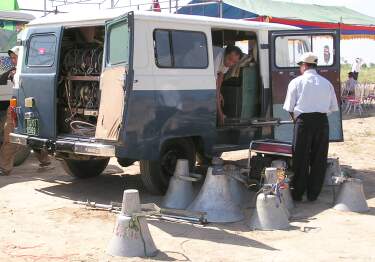 When the prime minister makes a speech like this one, it may have little to do with the actual occasion, such as dedicating a school. Instead the speeches often turn to politics and give the prime minister a chance to develop supporters in the local area. To insure that he is heard both by those present and by a nationwide radio audience, this sound truck follows him everywhere and provides a dependable sound system and a feed to the government-controlled radio networks.
When the prime minister makes a speech like this one, it may have little to do with the actual occasion, such as dedicating a school. Instead the speeches often turn to politics and give the prime minister a chance to develop supporters in the local area. To insure that he is heard both by those present and by a nationwide radio audience, this sound truck follows him everywhere and provides a dependable sound system and a feed to the government-controlled radio networks.
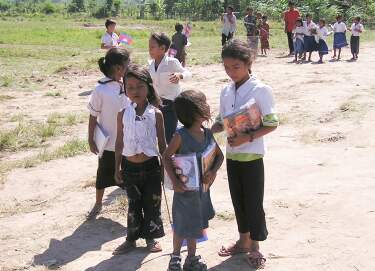
The prime minister also always hands out free student exercise books and new pens to the students who attend these rallies. They certainly earn them because they stand or squat for hours in the hot sun waiting for the official helicopter to arrive and then wait out the inevitably long series of speeches. Here a group of girls heads home with their spoils from the day.
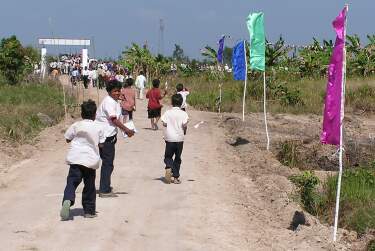
People are recruited from several miles around to attend these functions. Then when it is all over and the helicopters are out of sight, they start the long dusty walk back to their homes in the nearby villages.

After everyone else had left, one boy went around collecting Japanese and Cambodian flags left behind by the crowds. What will become of them? Who knows! Maybe they'll end up decorating some little hut somewhere.